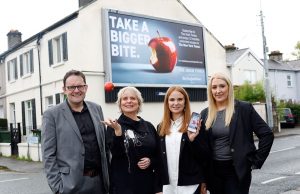
With video now accounting for around 74% of online traffic and billions being invested in online video advertising, brands, publishers and agencies are all scrambling to get a slice of the action, including Offscript, the joint venture between Independent News & Media and ShinAwil. Managing director Mitchell O’Gorman talks to John McGee about Offscript’s ambitious plans to turn the world of online video on its head.
Depending on who you talk to the golden age of TV may have come and gone but the golden age of online video is now upon us and by all accounts it is here to stay.
A recent report on the global online video market published by the Publicis-owned media agency Zenith estimates that online video viewing will have risen 20% in 2017 to around 47.4 minutes a day, up from 39.6m in 2016.
A recent eMarketer.com report on global online video consumption trends estimates that some 2.15bn people, or 29% of the world’s population, watch online videos at least a month and that this will rise to 2.40bn by 2020. Such is the commercial interest in online video, that brands and advertisers will spend an estimated $27.2bn this year on online video advertising and promotion, according to Zenith. By 2020, this will have risen to a whopping $38.70bn, it says.
While following the audience has always been an integral part of any media strategy, following the money is perhaps a much sounder proposition for any company looking to tap into this rapidly growing market.
One such company is Offscript, a 70:30 joint venture between Independent News & Media (INM) and ShinAwil, the Dublin-based production company headed up by Larry Bass and the producer of hit TV shows like The Apprentice, Dragons’ Den, MasterChef Ireland and
The Voice of Ireland.
While on the surface it might seem like an unlikely alliance, the ongoing fragmentation of audiences means that more and more consumers are turning to their phones or tablets to watch video-on-demand. And where’s there’s an audience, there’s a market to be developed.
Headed up by Mitchell O’Gorman, the former head of innovation and strategy at INM, Offscript will be a standalone business operating outside the INM and ShinAwil corporate structures from its new headquarters in Dublin’s Phibsborough.
“From an INM perspective, we were looking to create better quality video and from a ShinAwil perspective they are brilliant at creating really high-quality broadcast video and they’ve done a lot of that with brands but not a lot on digital platforms. So, it’s really taking the best of both worlds – INM’s digital and distribution expertise and marrying it with ShinAwil’s considerable production expertise- and creating something new and exciting that will allow brands to tell their stories online. There’s nothing like this in the market and it’s still a relatively new idea in other markets,” says Mitchell O’Gorman.
It was frustrating for us to watch the race to the bottom in terms of digital media. It’s the perceived cheapness of digital media and the lack of investment and production that goes along with that that is frustrating. We want to change that.
“It was frustrating for us to watch the race to the bottom in terms of digital media. It’s the perceived cheapness of digital media and the lack of investment and production that goes along with that that is frustrating. We want to change that. A lot of brand videos that have been created over the past few years have been really shocking, and you wonder how on earth a brand manager or a marketing director signed off on them. And the thing is if you asked the same brand manager or marketing director if they would have signed off on it if they knew it was going on TV and the answer would be a definite ‘no’. But if the answer is no, then they should never have signed off on it in the first place, regardless of which channel it’s going on,” he says.
How Offscript intends offering its services might surprise some industry folk.
“We will be looking to work directly with brands while we will also be looking to work with creative and media agencies and allow them think of new ways of telling their client’s brand-stories in a format that is not a 30 second ad. But we will also be working with other publishers as well and this is where it gets interesting from an INM and ShinAwil perspective. Although both our parent companies have vested interests in the market, we are going to work with the entire market. So, we are reaching out to rival publishers to see if we can create content for their channels. Likewise, ShinAwil is reaching out to rival production companies and looking to collaborate with them. Maybe they might have a great idea but haven’t got the resources and, if this is the case, we can leverage off our sales team by selling it to a brand and get the resources to make it happen,” he says.
“So, really early on we decided to pivot away from being a video content provider for just the INM platforms into being a content provider for whatever platform is the best to put it out. Some of the content that we create will go on the brand’s own platforms and probably won’t go near a publisher platform. And some of it will go to a channel that may be a rival to an INM channel. But when it comes to dealing with INM and Independent.ie, it will be up to them to give us the best rates they can and to prove the effectiveness of their channels,” O’Gorman says.
He points out that the original idea was to have an online player that would sit on the Independent.ie website but that has since changed. Offscript will also act independently of INM’s existing in-house studio and production facilities which are used primarily as an extension of its editorial offering. Now the focus will be on distributing the content through social media channels as well as a brand’s own channels.

“The reason being is that it allows for much better targetability of audiences and allows us to create much more niche content that talks to niche audiences. And that’s where the best data exists. But you also want people to engage with the content where they are,” he adds.
Together with Rob Treloar, Offscript’s head of sales, Steven Courtney, its creative director and Mark Holland, senior producer, the team have already met with some success.
“So far, we have worked with Ulster Bank, Electric Picnic, Tourism Northern Ireland, the British and Irish Trade Alliance and we have a few more clients in the pipeline here and in the UK. We are also looking to grow internationally, and we are at the very early stage of having discussions with Hearst in the USA about potentially going over and doing something with them. We are also looking at the Scandinavian markets.”
With numerous video production companies already out there and more and more media and creative agencies slowly immersing themselves in the content pool, O’Gorman is well aware of the challenges he faces.
For agencies, particularly media agencies, that don’t want to have to invest in production capabilities, there are many compelling reasons for them to be working with us. There’s a lot of investment that goes into creating a piece of content in terms of the resources.
“I think the number one challenge that we face is educating the market and letting brands, agencies and publishers that they can do really high-quality brand story telling on digital platforms through video. Yes, it does require investment, but our message is that instead of spending, say, €150,000-€200,000 on a 30 second ad, for less of an investment we can create a mini-documentary series for your brand that will run out over six months, rather than six weeks. And when you look at it in that context, it’s the shift from ‘we only pay one or two grand for a digital video’ that we need to address. We are in effect introducing a different way of brand story-telling to the marketplace that goes beyond the 30 second ad slot and way beyond the poorly produced videos that are out there. Our content will deliver greater engagement, greater targetability and much greater opportunities for storytelling. And the reality is that this is not being done at a high quality at the moment. So, we think there is a massive opportunity, but there’s an educational piece that needs to be at the centre of this,” says O’Gorman.
“For agencies, particularly media agencies, that don’t want to have to invest in production capabilities, there are many compelling reasons for them to be working with us. There’s a lot of investment that goes into creating a piece of content in terms of the resources. We already have the technical expertise, the equipment and the story-telling capabilities and it doesn’t really make financial sense for an agency to go out and do all of this on its own if they are just working on a project-by-project basis,” he adds.
One of the interesting trends that appears to be emerging in the online video world is the growth in long-form content and the devices that people are consuming it on. He says that 74% of all internet traffic is now video, with long-form content – over 20 minutes in length- now accounting for 63% of all time spent watching across all devices. While TV has always been the device of choice for long-format content, the shift to mobile and tablets hasn’t curbed consumer’s enthusiasm for it. In fact, it has accelerated its growth and appeal.
With the exception of AIB’s #TheToughest and the TV documentary “The Toughest Trade” as well as Vodafone Ireland’s rugby documentary, “What We Did Last Summer,” not many Irish brands, have dipped their toe in long-form content, preferring instead the perceived comfort of short-form, which comes with many limitations says O’Gorman.
“So many brands have tried to cram their story into 10 seconds and this has severely limited their story-telling ability. We think that there’s a much better way for brands to tell their stories in longer form. And when we are talking about long-form, it doesn’t necessarily have to be an hour or even thirty minutes – it could be three minutes. What’s important is that it gives the brand the time and space to breathe and tell its story in an engaging way,” he adds.
“The reality is people aren’t engaging with some of the short-form brand content out there because it’s rubbish, it hasn’t been invested in and they haven’t used the right story-telling techniques and applied them.”
He says that that it’s a misconception when people say that consumers won’t engage with long-form content because they are so used to short-form videos popping up on whatever social media channels they use.
“It’s not true of YouTube but it is true of Facebook to an extent. But again, I would argue that there isn’t enough good and engaging long-form content out there to make people stop, pause and take their time to share it. In fact, this hasn’t been lost on Facebook and it is already on to it with the creation of Facebook Watch. Although it hasn’t launched in Ireland yet, it’s a new platform that’s going to house multi-episode longer-form video content. We’re delighted because it reinforces what we already instinctively knew: people will engage with long-form story-telling if it’s done in an engaging and compelling manner and I think you will see more social media platforms going down this route too. Hopefully, this will play into our hands,” O’Gorman concludes.
First published in Irish Marketing Journal (IMJ November 2017)© to order back issues please call 016611660























